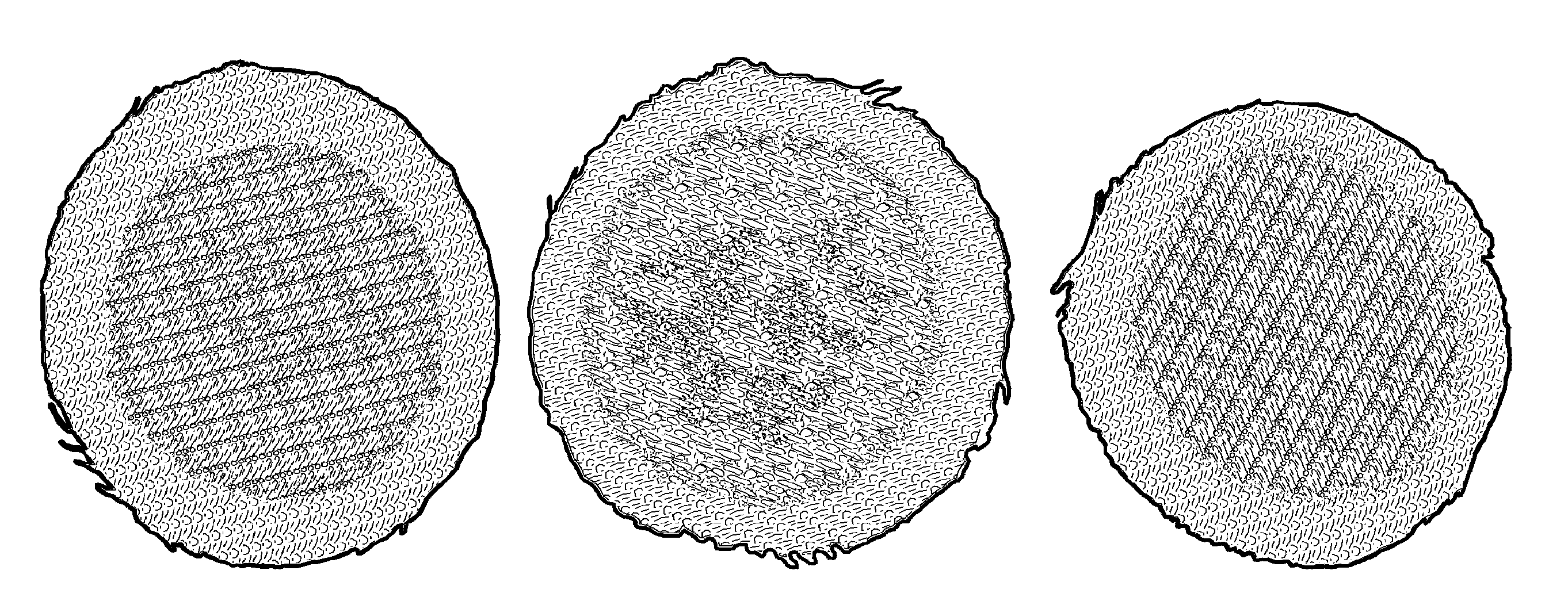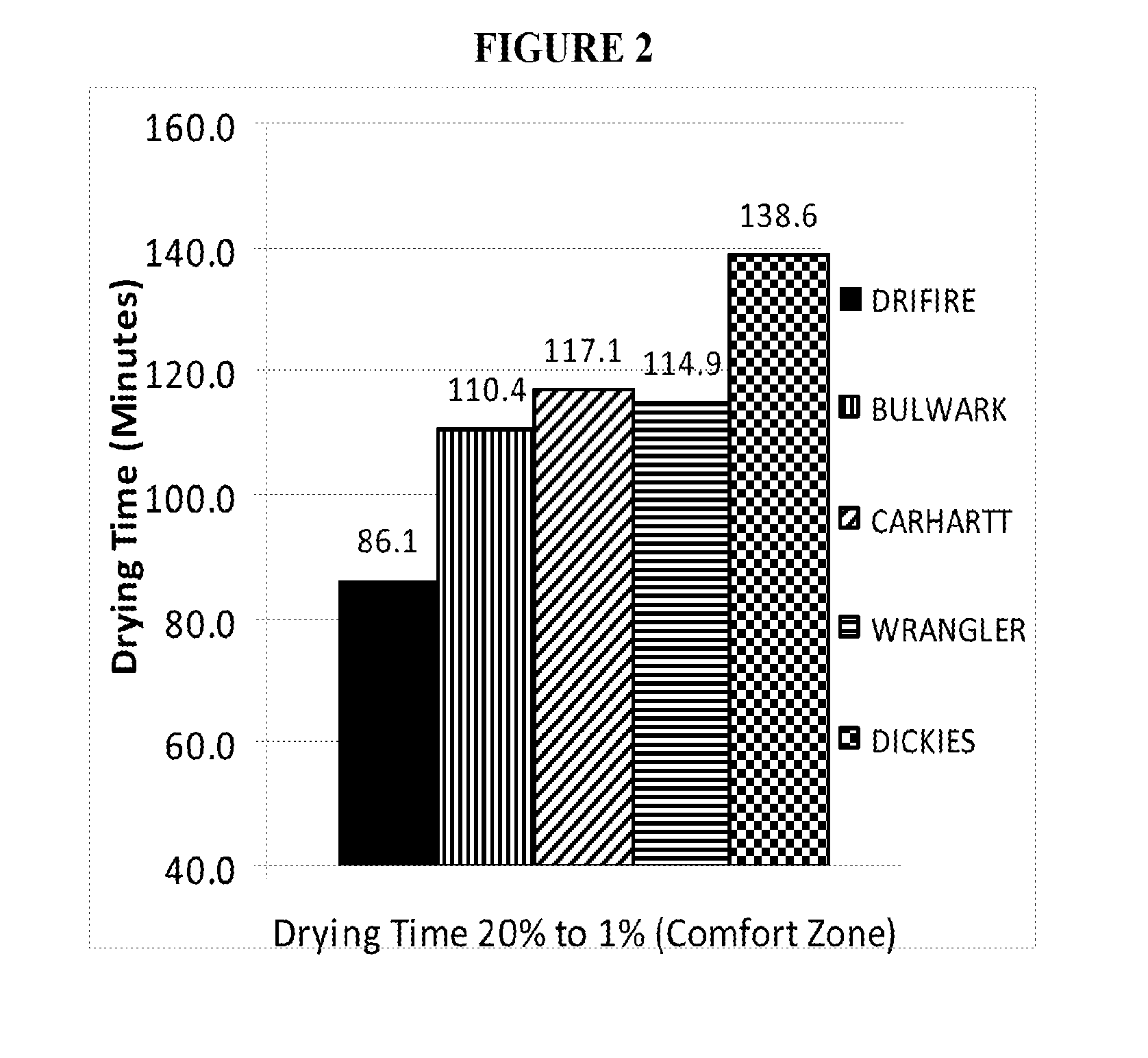Fire resistant woven fabrics and garments
a technology of woven fabrics and garments, applied in the field of fire-resistant fabrics and garments, can solve the problems of reducing or eliminating the fabric properties, adversely affecting the comfort of laundering, inconvenience, and additional costs, and achieves superior moisture management properties, abrasion resistance, and moisture management. the effect of reducing the risk of fading
- Summary
- Abstract
- Description
- Claims
- Application Information
AI Technical Summary
Benefits of technology
Problems solved by technology
Method used
Image
Examples
example 1
[0171]The tumble dry times were compared for denim pants made from the woven fabric of the invention and commercial available fire resistant (FR) 100% cotton denim pants from Bulwark.
[0172]Tumble Dry Time Test was conducted as described below:
[0173]A load of FR Denim Pants (6 pants per load of Drifire or Bulwark) was subjected to a wash cycle at Warm / Cold setting in top loading American Washer (Sears Kenmore 70 Series Heavy Duty Plus) using 44 g of AATCC detergent. Dry weight was recorded for both loads prior to washing. Wet weight was recorded after washing. Then the load was tumbled dry at Medium Heat-165° F. Dryer used was Continental Industrial Dryer CG30-40 dryer with a capacity of 35 pounds dry weight. After running the dryer for 25 minutes, dryer was stopped and weight of the load was recorded every minute. Load was considered dry when the weight of load reached the initial dry weight. Drying time was reported. The results are shown in Table 1 below.
TABLE 1Wet PickDrying Time...
example 2
[0175]The performance of four commercially-available FR denims (from Bulwark, Carhartt, Wrangler, and Dickies) were compared to the performance of the woven fabric of the invention (Drifire FR Denim T-3907) in terms water release rate (WRR), drying time, horizontal wicking, vertical wicking (moisture management) and abrasion resistance. The results are shown in Table 2 and Table 3 and in FIGS. 1 to 8.
TABLE 2Vertical% WeightWickingLoss afterWetHorizontalLength (inAbrasionWeightPick-UpWicking5 minutes)(10,000 Cycles)Item / FabricFiber Content0z / Sq. Yd.%secondscm%Drifire Style#weft:15.2543.65%0-15.71.66%T-3907 (175% modacrylicWash-Home10% nylonLaundering)15% cottonFR Denim1warp:100% cottonoverall fabric:57% cotton38% modacrylic5% nylonBulwark FR100% cotton15.3447.62%22-264.85.74%Denim (asreceived)Carhartt FR100% cotton11.7045.10%18-214.34.49%Denim (asreceived)Wrangler FR100% cotton15.5051.02%12-135.21.73%Denim (asreceived)Dickies FR100% cotton14.0048.40%>600.34.08%Denim (asreceived))WRR ...
example 3
[0189]Flame Resistance of Textiles (Vertical) (ASTM D6413):
[0190]This test method determines the response of textiles to a standard ignition source, deriving measurement values for after-flame time, afterglow time, and char length. The vertical flame resistance, as determined by this test method, only relates to a specified flame exposure and application time. This test method maintains the specimen in a static, draft-free, vertical position and does not involve movement except that resulting from the exposure. Test Method D6413 has been adopted from Federal Test Standard No. 191A method 5903.1, which has been used for many years in acceptance testing.
[0191]Samples cut from fabric to be tested are mounted in a frame that hangs vertically from inside the flame chamber. A controlled flame is exposed to the sample for a specified period of time. After-flame time, the length of time the material continues to burn after removal of the burner, and after-glow time, the length of time the m...
PUM
| Property | Measurement | Unit |
|---|---|---|
| Temperature | aaaaa | aaaaa |
| Fraction | aaaaa | aaaaa |
| Fraction | aaaaa | aaaaa |
Abstract
Description
Claims
Application Information
 Login to View More
Login to View More - R&D
- Intellectual Property
- Life Sciences
- Materials
- Tech Scout
- Unparalleled Data Quality
- Higher Quality Content
- 60% Fewer Hallucinations
Browse by: Latest US Patents, China's latest patents, Technical Efficacy Thesaurus, Application Domain, Technology Topic, Popular Technical Reports.
© 2025 PatSnap. All rights reserved.Legal|Privacy policy|Modern Slavery Act Transparency Statement|Sitemap|About US| Contact US: help@patsnap.com



